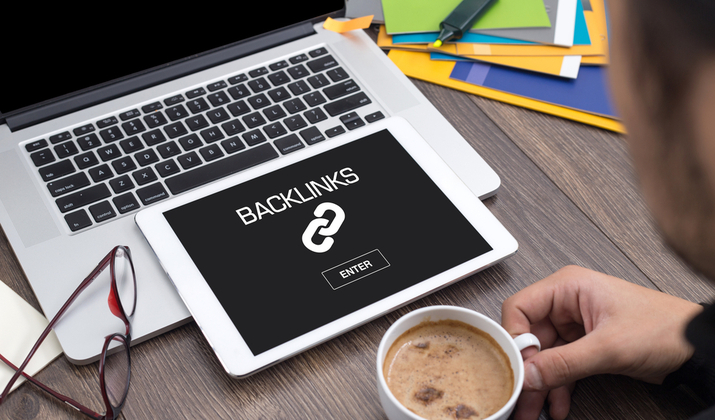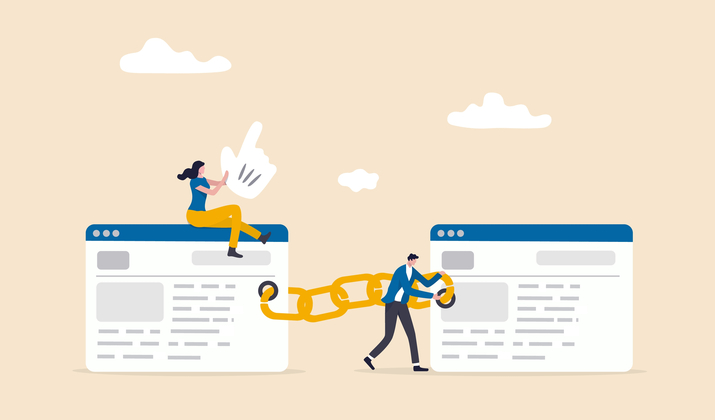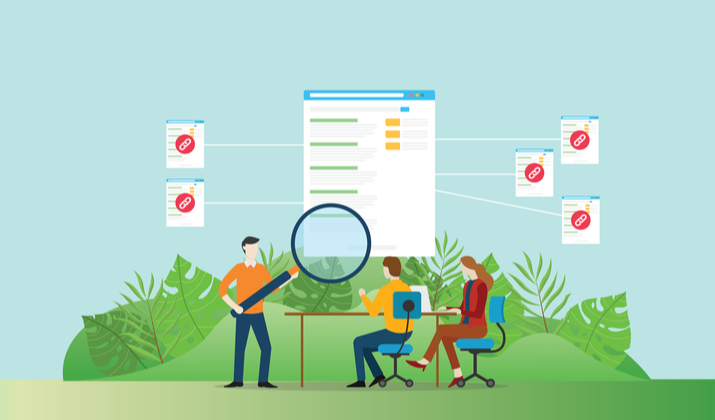Link building is a technique that boosts site ranking on search engines and backlinks are among the factors that Google considers when ranking a website.
Backlinks are often generated from a website page to another site. The more of these you have on your site, the higher the likelihood of you ranking for the particular keyword on Google.
But backlinks can turn bad, especially when misused. It’s imperative that you identify bad links to prevent harm to your website. Because if you don’t, your site will suffer in organic traffic, rankings, and revenue.
Crowding your site with all kinds of backlinks isn’t going to get you on Google’s first-page ranking. That’s why you must have a powerful strategy to build high-end links that will get you on top of the search pages for competitive keywords.
In this article, we want to explore deeper into toxic backlinks, how to identify them, and remove or fix them.
Understanding What Toxic Backlinks Are
Source: Shutterstock
Toxic backlinks are those unnatural links that affect your website’s search engine rankings. They tend to harm your rankings or weaken your site’s SEO.
With a weak SEO, you are bound to experience low organic traffic from search engines. And you know that less organic traffic amounts to few site visitors and a small number of leads, which definitely means lower sales for you.
There are times when toxic backlinks occur organically, but this only happens on rare occasions. For instance, when your previous efforts to link building negatively impact your SEO due to the search engine’s change of heart on particular types of backlinks.
At other times, bad backlinks may invade your site when you use certain link-building schemes (negative SEO) to manipulate your page rank in Google.
Where Do Toxic Backlinks Come From?
Before embarking on cleaning up your site of toxic backlinks, you need to identify their origin.
Let us understand clearly how these links land on your pages.
1. Through the Comments on Your Blogs
Comment spam has been a plague to blogs. Most bloggers receive a lot of comment spam (unsolicited comments). This is because spammers use tools to generate feedback that helps them generate feedback and obtain high rankings on Google.
2. From Unsecured Websites
The security of your website is fundamental. Without safeguarding your site, it will become vulnerable to hackers. If you leave it without solid protection, your SEO will get hurt.
It is always wise to get an SSL certificate on your website, not only for protection but also for boosting your SEO rankings.
3. From Spammy Sites Designed Specifically for Link Building
Spam sites always perform link building using aggressive techniques. They use automated links and excessive link trade to churn out massive links to your site within a short time.
However, some of the links channeled to your site originate from sites that can harm your SEO. That’s why you should be careful enough to avoid such sites as much as possible.
4. From the Mirrored Pages
Receiving multiple backlinks from websites using the same anchor text can send an alert to Google. The search engine takes it as a link-building scheme, and your website can get penalized for violating the Guidelines from Google.
5. All the Sites Violating Google’s Guidelines
There are many websites that don’t follow Google’s guidelines. Such sites can be the source of toxic backlinks that will bring your site down.
You should always refer to Google’s webmaster guidelines when using links from other sites. This can help you avoid injecting illicit practices into your site. If Google finds you out, your site will be penalized for manipulating the PageRank.
Toxic backlinks can also come from irrelevant websites and irrelevant content, and hidden links at the footer of your website.
There are others which are omnipresent on your site and those that are marked as sponsored. It may not be easy to identify these without conducting a backlink audit.
What Impact Do Toxic Backlinks Have on Your Website?
Source: Shutterstock
Penalization
When Google decided to reward quality websites for efforts well earned, it also wanted to penalize those with a lot of keyword stuffing and manipulative link schemes.
That’s why the search engine released Penguin and refined the algorithm to catch and penalize sites with bad links.
Google penalties are often triggered by
- The issues detected algorithmically by Penguin
- Finding yourself in a niche monitored by the Google spam team
- Reports from competitor websites
- A Decline in PageRank
When your site has toxic backlinks, you’ll experience a plunge in organic traffic. This may happen to a few web pages or the whole site, depending on how extensive the backlinks are.
The worst-case scenario in this particular case would be for Google to remove you from its search index. If this happens, you’ll have to take immediate action to resolve this issue.
Getting Ignored
Unnatural or useless links will not be approved by Google since they won’t affect your site’s organic traffic. The search engine will recognize the backlinks but will ignore them entirely.
How Can You Detect Toxic Backlinks?
Getting a link from a low-trust host website can be dangerous. Toxic backlinks may not be streaming in large volumes, but they could be a few paid links from link networks or link schemes.
The common signals from toxic backlinks come from sites with very low trust and keyword-focused links with unnatural anchor text.
Google Webmasters will warn you about the toxic backlinks profile of your website. It is essential to understand your backlink profile first before looking for negative SEO and toxic backlinks initiatives.
Start the process of identifying by analyzing those backlinks with very low Trust value, and you’ll definitely find them.
If your organic traffic starts decreasing, you know that your site has been penalized – probably because of toxic backlinks.
What you should do is find the list of all the backlinks on your website. Use Google Webmaster Tools, Majestic SEO, Ahrefs, or SEOmoz to get the whole list of those backlinks.
How to Fix Toxic Backlinks?
If you make a habit of checking your website’s health and backlink quality regularly, you’ll manage to catch any toxic backlinks as soon as they emerge. This will enable you to prevent actual damage to your site and SEO rankings.
Follow these steps to keep your site safe.
Get Hold of Those Toxic Backlinks
Conducting a backlink audit on your website on a regular basis will help you prevent the toxic backlinks from affecting your website’s performance.
Use audit tools like the SEMrush Backlink Audit Tool to audit the backlinks on your website. To use this tool, just enter your domain name in the search bar, and the system will automatically start analyzing your backlinks.
Once it’s done, it will provide a backlink score and show you the quality of every backlink on your website. From there, you can list down the domain of each toxic backlink.
Now to the next step.
Contact the Owners of the Websites with Bad Links
Source: Shutterstock
After identifying all those toxic backlinks on your site, reach out to the website owners and tell them to remove the links from your site.
Send them a simple request asking them to take them off your site. You don’t necessarily need to give reasons. However, this action may or may not work. In case it doesn’t work, you can remove the links in another way, as explained in this next step.
Disavow the Harmful Backlinks
If you don’t succeed in contacting website owners, you can opt to disavow the toxic backlinks yourself. Google has a tool on its Search Console that can enable you to disavow any harmful backlinks on your site.
The only thing you should do before disavowing these links is to determine whether doing this is the right solution. Google guidelines advise you to take this action only if:
- Google has taken manual action against your site
- You have verified that your website has toxic backlinks
- You are sure that Google is going to take manual action against your site
If you’re sure that your website contains toxic backlinks, then you can go ahead and disavow them. But if you aren’t, make sure to perform an audit on your backlinks before disavowing them. Remember, incorrect usage of the tool can harm your website.
To get started with disavowing, list all those links in a text file encoded in 7-bit ASCII or UTF-8 as stated in Google Webmaster guidelines.
With the list ready, use the Google Search Console Tool to disavow all the backlinks on the list. To do this, upload your list on the tool. Google Search Console Tool will also overwrite the previous list you uploaded before.
Just remember that your request may be processed after a few weeks. That is when your disavowed links will be shown on your Links report.
Also, keep in mind that disavowing the bad backlinks won’t help you escape the penalty. It will not also get your ranking back if you lost it. In case you are already penalized by Google, you may have to remove every harmful backlink manually.
There might also be backlinks on your site that you had built years ago, which don’t comply with Google’s new rules. If you notice such links, you’ll have to remove those that are within your control.
What Next, After Removing Toxic Backlinks?
Once you are done cleaning up the bad backlinks from your website, file a reconsideration request with Google. Doing this is admitting your fault.
Outline all the steps you’ve taken to resolve the problem and promise to adhere to all the best SEO practices from thereon. It may take you about two to three weeks to get a response from Google, and if lucky, your website will be back in action.
Now that your site is free from harmful backlinks, you should start planning on building new, quality backlinks. You’ll need a successful strategy that will help boost your website’s Trust Flow score.
Keeping Toxic Backlinks at Bay
Source: Shutterstock
It’s pretty tricky to prevent toxic backlinks from your website. Many websites have been created just for the purpose of harming other sites – that’s how twisted hackers minds are,
It is impossible to completely keep toxic backlinks away. But you can beat this by keeping an eye on all your site’s backlinks.
By keeping tabs on all those websites linking off to yours and analyzing the links’ toxicity levels, you’ll be able to take action on time.
Remember, toxic backlinks can harm your search rankings and how Google perceives your website. And your SEO efforts will go down the drain.
To keep bad backlinks from harming your site rankings, conduct regular backlink analysis – once in a month is quite okay. It will help you catch the backlinks as soon as they show up and allow you to eliminate them before they cause damage.
Don’t be swayed by links from enticing sites that publish your guest posts instantly without any policies or guidelines. If push comes to shove, hire a professional who identifies with quality sites and has the knowledge, experience, and high-end, reliable tools for the job. This will save you a great deal from attracting toxic backlinks to your website.
In Conclusion
Your website’s success depends on backlinks – quality backlinks. With quality backlinks, the search engines will consider your site a trustworthy source of valuable, relevant content.
But when toxic backlinks invade, they make your site look harmful, sketchy, just like the sites they originate from. This creates a negative association that will immediately be recognized by Google.
It is important to be on alert and perform a regular backlink audit. This process can be arduous and takes time. However, your efforts will pay in the long haul. Don’t hesitate to contact website owners of these bad backlinks. It will save you the efforts of having to fix these links and the harm they’ve caused.



